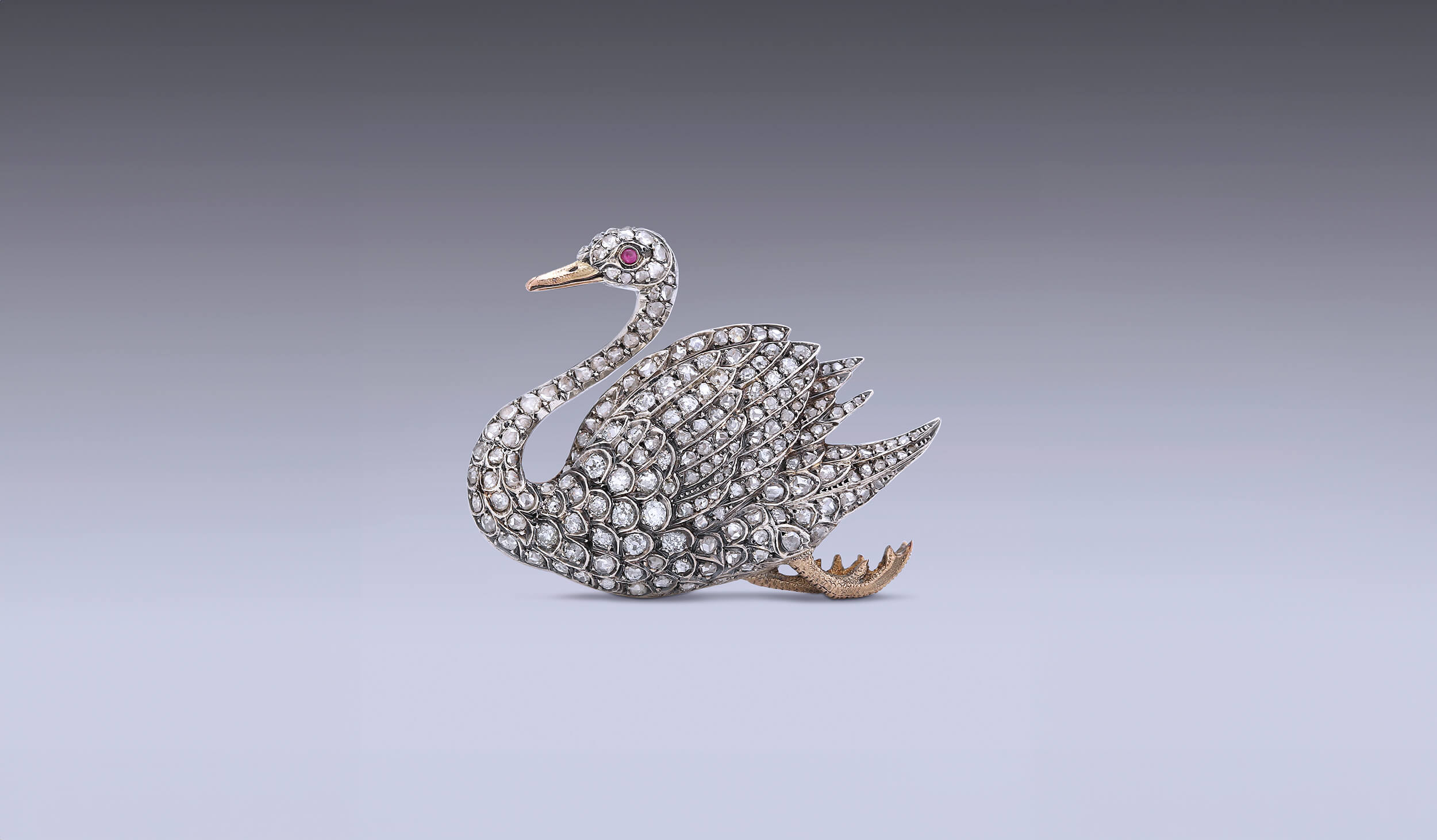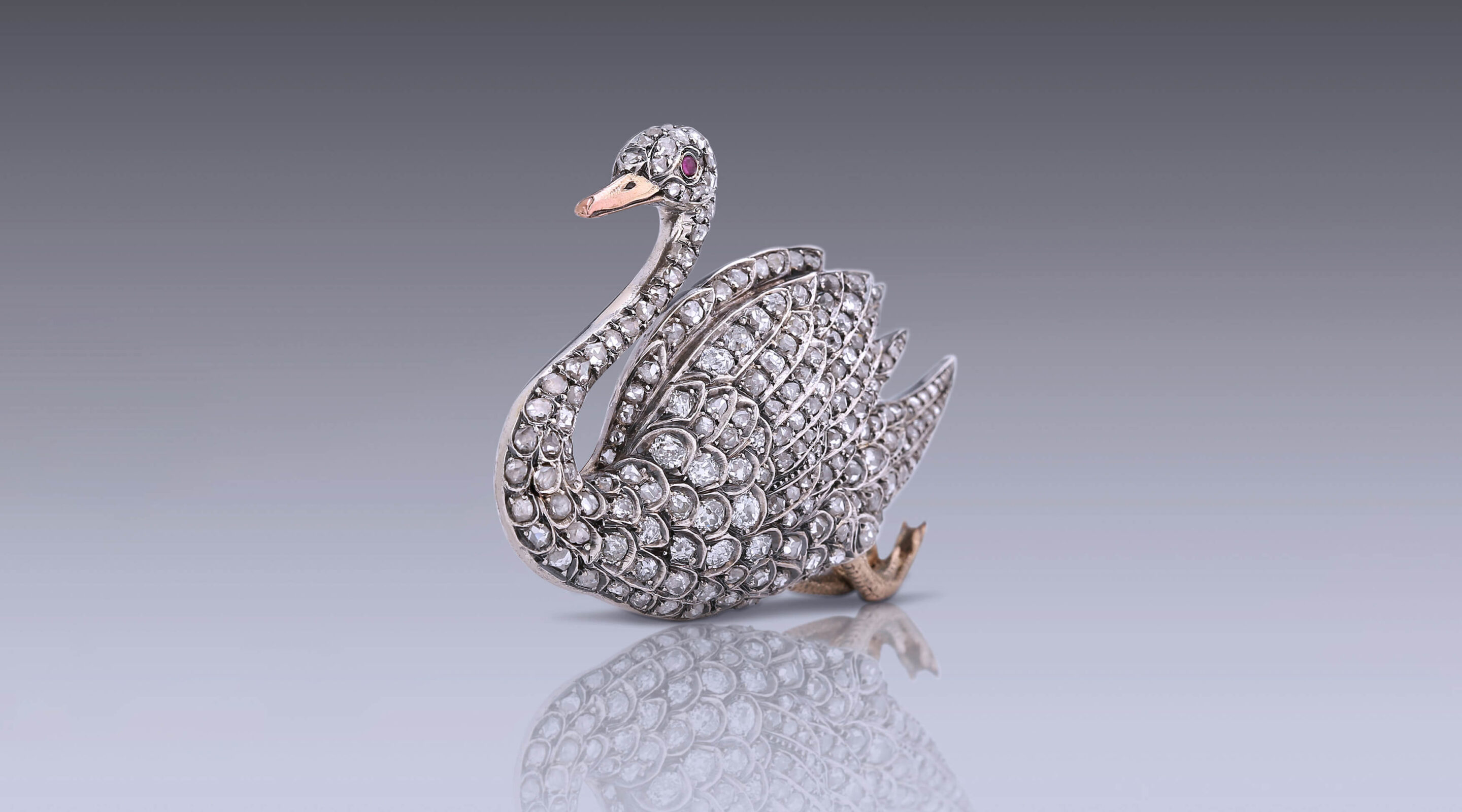This elegant brooch in the shape of a swan swimming was made in England in the last quarter of the nineteenth century. A period known as the Victorian age, reflecting the lengthy reign of Queen Victoria, from 1837 until her death in 1901. The Victorian age was seen as a very prosperous time thanks to immense economic and industrial progress. There was great interest in animals in Victorian culture. Domestic pets were increasingly found in the houses of the elite. Pedigree dogs and cats as well as exotic animals like parrots and monkeys were a symbol of the owner’s wealth, status and class. Stuffed animals were displayed in museums and people could gape at the animals in travelling circuses. This interest in animals was picked up by jewellery designers, for whom animals became an important source of inspiration. Towards the end of the nineteenth century there was a huge repertoire of animals in jewels, including dogs, cats, horses, ducks, rabbits, mice, monkeys, bears, bats and lions.
Diamond Swan Brooch
Silver on Gold
This rather large swan is made of silver on gold and set with brilliant and rose-cut diamonds. The feathers in the wings are built up in layers, giving the swan a three-dimensional effect. The bill and the webbed feet are realistically formed in rose gold. The eye is set with a ruby. In the mid-nineteenth century yellow gold jewels with coloured stones or enamel were in fashion, but after the first diamond was found in South Africa in 1867 there was instant interest in these precious stones. Before they were mined on a large scale in South Africa, the gem was so rare and expensive that only the very richest could afford them. Growing prosperity in western countries meant that more and more people could buy diamonds. Goldsmiths at that time thought that precious stones appeared to greatest advantage in a silver setting. Setting the diamonds in cooler silver made them sparkle more brilliantly than they did in gold. However, if silver was worn directly on the skin or clothes it could tarnish through oxidation and leave black marks. Jewellers overcame this by making the back of the brooch in gold, as was done in this case. It was not until around the turn of the century, at the end of the nineteenth century, that platinum was used in jewellery. This metal was much harder and so could be made thinner, and it had the advantage of not discolouring. Because the craftsmen were so used to making jewels with two colour layers it was still being done then – but with platinum and gold, although there was no longer any need to. This can still be found even in some later jewels.
Pair for Life
Swans are one of the few animals that pair for life, they are monogamous and often stay faithful to the same partner until they die. The bird is above all a symbol of love and fidelity and is a much-loved subject in art. The swan also appears in myths and stories all over the world. The most famous Greek myth is the story of Leda and the Swan, in which the god Zeus assumes the form of a swan to seduce his great love, Leda.
Swan Upping
In England the swan was deemed a royal bird from the Middle Ages. Although it was also seen as a symbol of hypocrisy – the swan’s flesh is black, but this is concealed by its white plumage – the long, curved neck and white plumage made it a symbol of noble purity.
All swans on open and common waters were the property of the crown and only the monarch could grant the privilege of owning a so-called game of swans to individuals or institutions. The common people were not allowed to keep swans, and even aristocrats had to ask permission to own and eat them. The swans had to be marked and pinioned to assist in any dispute regarding ownership, a task overseen by the Swan Master and his regional deputies. This was recorded up to the 19th century in a Swan Mark Registers of Owners. The annual marking of new cygnets was known as swan upping. Today, although a protected species, the swans in England are still under the king’s protection.
Delicacy
Swans were eaten as a delicacy, an ultimate luxury, reserved for royal houses and the fabulously wealthy. They were cooked in pies, which were served spectacularly with a stuffed swan on top. Eating swans fell out of favour in the eighteenth century, but they could still often be seen on the banqueting table as a motif in the Victorian age. Pies, aspic, ices, nougat, butter and countless other delicacies appeared in the form of elegant swans.
Marked with French import marks for gold and silver, an owl and a swan.
This site is protected by reCAPTCHA and the Google Privacy Policy and Terms of Service apply.

